Spring Break in Guanajuato
Saturday, March 10 - in the morning, we did a walking tour of the city, including a visit to el centro - the downtown area. We also rode the funicular (incline) up the mountain that evening to look out over the city. Tracy Dietz - social work professor
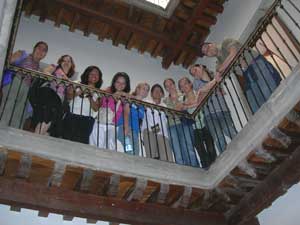 Sunday, March 11 - some students went to mass in the Basilica, then an historical tour. We all went to Diego Rivera's house (pictured on the left) where he was born and lived up till he was six years old. The house is restored to the time (late 1800's) when he lived there and is a museum with many of his early painting and sketches from some of his famous murals and other works.
Sunday, March 11 - some students went to mass in the Basilica, then an historical tour. We all went to Diego Rivera's house (pictured on the left) where he was born and lived up till he was six years old. The house is restored to the time (late 1800's) when he lived there and is a museum with many of his early painting and sketches from some of his famous murals and other works.We also visited the Alondiga, a museum that is the site of the birth of the Mexican Independence. The Alondiga was built by the Spaniards as a grainery. When the independence movement began, the Mexican army arrived in Gto, the Spanish locked themselves - and much of their gold and valubles - inside the Alondiga. The Mexican army was able to break into the building and won their first battle against the Spanish army. On Sunday afternoon, we enjoyed a fiesta with the host families. Tracy Dietz, social work professor
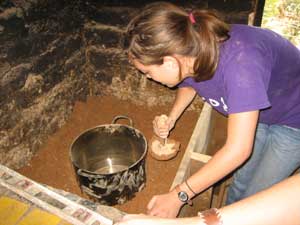 Monday, March 12 - Today was our first day going out to Hacienda de Arriba, the community we’re working in near Santa Rosa. Our drive to the community in the morning was absolutely gorgeous. When we got to the bottom of the hill and the small group of houses, the people came out to greet us and show us around. They took us up a steep hill to the grandmother’s house and showed us the area where the women cook. Even though I’d already seen pictures of the soot covered walls, it was still shocking to see.
Monday, March 12 - Today was our first day going out to Hacienda de Arriba, the community we’re working in near Santa Rosa. Our drive to the community in the morning was absolutely gorgeous. When we got to the bottom of the hill and the small group of houses, the people came out to greet us and show us around. They took us up a steep hill to the grandmother’s house and showed us the area where the women cook. Even though I’d already seen pictures of the soot covered walls, it was still shocking to see. Work began on the first stove. We all worked on it so that we could see how it was done. I’m really eager to continue working over the week. The people of the community were incredibly friendly and excited that we were there. It was amazing that with such little they had, they were still eager to share with us. They practically force-fed us before we left!
Later, we met Señora Faffie, the former director of the state social service department. She was extremely inspiring, talking about her years working in Guanajuato (she’s been working here for over 30 years!) and her struggles to realize her project visions. She started the Mi Casa Diferente program, which has built over 1200 houses in the state of Guanajuto. It was really moving to hear her talk about getting out into the communities to help those who were really in need. She really emphasized the need to just get out and get your hands dirty instead of always planning and preparing. Overall, today was a great start to what I hope will be a great week of service. Maggie Thiesen, student
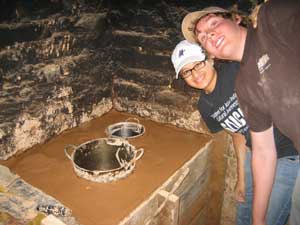 This is the top of the first stove, after we finished putting in all the mud/sand mixture, and smoothed it all off. This part must dry overnight, and then we remove the forms and the pots. The pots are in the mixture as a mold for the main burner areas. Jacob Bloch, student
This is the top of the first stove, after we finished putting in all the mud/sand mixture, and smoothed it all off. This part must dry overnight, and then we remove the forms and the pots. The pots are in the mixture as a mold for the main burner areas. Jacob Bloch, student  Tuesday, March 13
Tuesday, March 13Today was our second day of the project. Again we all rose early and left the Presa (the area of town where we’re staying) around 8:30 a.m. The drive to the site was again beautiful as we wove out of the valley in which Guanajuato resides into the surrounding hills and beyond. The work picked up as there was a lot more to do – some of us pick axing and gathering soil from the hillsides (to mix more of the LORENA mix), while others worked to finish off the first stove, digging tunnels between the burners and then to the top (where a pipe would be attached to act as a chimney moving the smoke outside) Another project we began was construction on the second stove. A hearth would first have to be created so adobe bricks had to be carried in from the far side of the village.
The work was difficult and tedious, but the first stove was completed as well as the hearth for the second one, so everyone was really impressed with our progress. Later in the day we went to visit Buen Pastor, a girls orphanage in Guanajuato. It was a wonderful experience. Most of us played basketball with the girls or gave them our digital cameras to take pictures with (which they all loved). Then we served them a dinner of hot dogs, which are apparently a big favorite. We all communicated with them to the best of our abilities and were amused by the dynamic between the joyous and animated girls and the stern nuns in charge of them. The nuns couldn’t turn their backs without some sort of absurd antics taking place. Both working on the stoves and visiting the orphanage were incredibly rewarding experiences and everyone is looking forward to tomorrow. Jacob Bloch, student
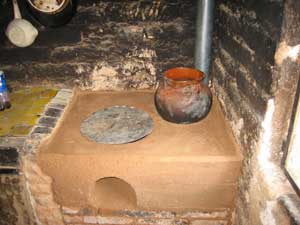 Wednesday, March 14
Wednesday, March 14We really worked hard at the community today. All the families are part of the same big family, so everyone is working together to make the stoves. We mixed all the sand, cement, calcium, dirt, and water together and poured our second stove while the families worked on another only a few yards away in another kitchen. We also got to see the other kitchens where we’re going to be making the new stoves. Everybody got pretty dirty today mixing and pouring, as well as cleaning out the old stoves. Pretty much everyone ended up covered in ash and dirt, but there were (tired) smiles all around. The road down is pretty tough, so we could only get one of the cars down to the village. We took two shifts heading back today, but everyone was home to shower and eat by about 3:30 p.m.
Because of how hard we’ve been working we got the afternoon off. We reconvened at the Embajadoras restaurant. We all talked for a while, then had a “breakdown” session like we do every night. Tunti and Barbara led it, and asked everyone how they thought that we could fight poverty. Everyone weighed in, and it really tied together everything we’ve been seeing all week. Students noted how apathetic college students can seem, sometimes feeling that their “emotional connection” to a movie or situation is the same as contributing. Several talked about the Invisible Children movement at TCU, and how so many people seem affected by the showings but don’t necessarily do anything different once they leave. We talked about aid work being dependent on a personal connection, and how we could extend our experiences past this week in Mexico.
I think that everyone on the trip is being impacted by the work we’re doing and the people and places we’re seeing. Such diverse experiences really seem to be touching each person differently. For me, the important thing about this trip isn’t necessarily the physical work we’re doing, it’s the experiences and connections being made both by the students and members of the community. The things we’ve done create impressions and memories that will extend far beyond this trip, and give us an opportunity to think critically about how we live our day to day lives, and how we can think and act more globally. Tomorrow promises to be a day of hard work, but everyone seems positive. Everyone likes the work, though I think the part we really enjoy is interacting with the people. As we begin the second half of our work week, I’m really excited to start the last few stoves and to see our hard work bear fruit. Hunter Shelburne, student
Thursday, March 15
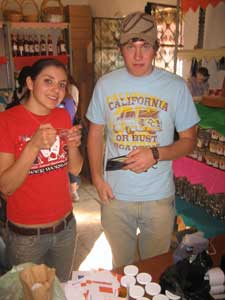 Today was a day where we all had to demonstrate flexibility and the ability to adapt to changes in schedules and plans. We arrived at the community a little later than usual but we had the opportunity to visit Conservas de Santa Rosa in the village of Santa Rosa, which we pass through on our way to the community we work in. Conservas is a co-op run by a group of women in the town. They make jams and liqueurs that they sell locally and also produce for major businesses in Mexico. Cuerpos de Conservación, the same group that we're working with, has helped Conservas de Santa Rosa to become a success and benefit the community as a whole. All of us got to sample the delicious jams they made - strawberry, guava, even cactus!
Today was a day where we all had to demonstrate flexibility and the ability to adapt to changes in schedules and plans. We arrived at the community a little later than usual but we had the opportunity to visit Conservas de Santa Rosa in the village of Santa Rosa, which we pass through on our way to the community we work in. Conservas is a co-op run by a group of women in the town. They make jams and liqueurs that they sell locally and also produce for major businesses in Mexico. Cuerpos de Conservación, the same group that we're working with, has helped Conservas de Santa Rosa to become a success and benefit the community as a whole. All of us got to sample the delicious jams they made - strawberry, guava, even cactus!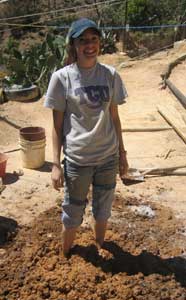 At the community we divided into basically three groups to complete our tasks for the day. Some workers spent the day digging the tunnels in the stove that we constructed yesterday; others began the construction of the stove in Doña Maria's house, preparing the mixture of dirt, sand, cement, calcium, and water and layering and compacting the material into the existing foundation. A few of us left the others to prepare adobe bricks that would be used for the base of the grandmother's stove.This afternoon was also set for a meeting with some representatives of DIF (the state social services department) to talk about the speech pathology profession here in Guanajuato. A small group of us left the community early and met with some professionals, including psychologists, teachers, and physicians who were taking a three-week intensive course focusing on the field. We spoke with them and asked questions about the educational training and professional practice here and also discussed the possibility of establishing an exchange or some type of externship experience for speech pathology graduate students from TCU.
At the community we divided into basically three groups to complete our tasks for the day. Some workers spent the day digging the tunnels in the stove that we constructed yesterday; others began the construction of the stove in Doña Maria's house, preparing the mixture of dirt, sand, cement, calcium, and water and layering and compacting the material into the existing foundation. A few of us left the others to prepare adobe bricks that would be used for the base of the grandmother's stove.This afternoon was also set for a meeting with some representatives of DIF (the state social services department) to talk about the speech pathology profession here in Guanajuato. A small group of us left the community early and met with some professionals, including psychologists, teachers, and physicians who were taking a three-week intensive course focusing on the field. We spoke with them and asked questions about the educational training and professional practice here and also discussed the possibility of establishing an exchange or some type of externship experience for speech pathology graduate students from TCU.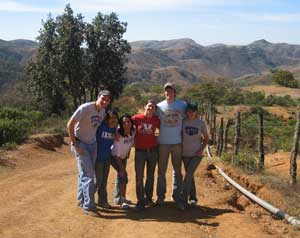 Those remaining in the community completed the work for the day and after cleaning up set out on the journey home. Since the earlier group had taken the vehicle as transportation to DIF, the others ended their workday with a hike to Santa Rosa followed by two bus rides to their destination in Guanajuato. It was a later day for some, but a lot of work was accomplished. Only one day remains to work in the community, so everyone will be resting tonight for our last day of service for this trip. Mary Bauman, student
Those remaining in the community completed the work for the day and after cleaning up set out on the journey home. Since the earlier group had taken the vehicle as transportation to DIF, the others ended their workday with a hike to Santa Rosa followed by two bus rides to their destination in Guanajuato. It was a later day for some, but a lot of work was accomplished. Only one day remains to work in the community, so everyone will be resting tonight for our last day of service for this trip. Mary Bauman, student








